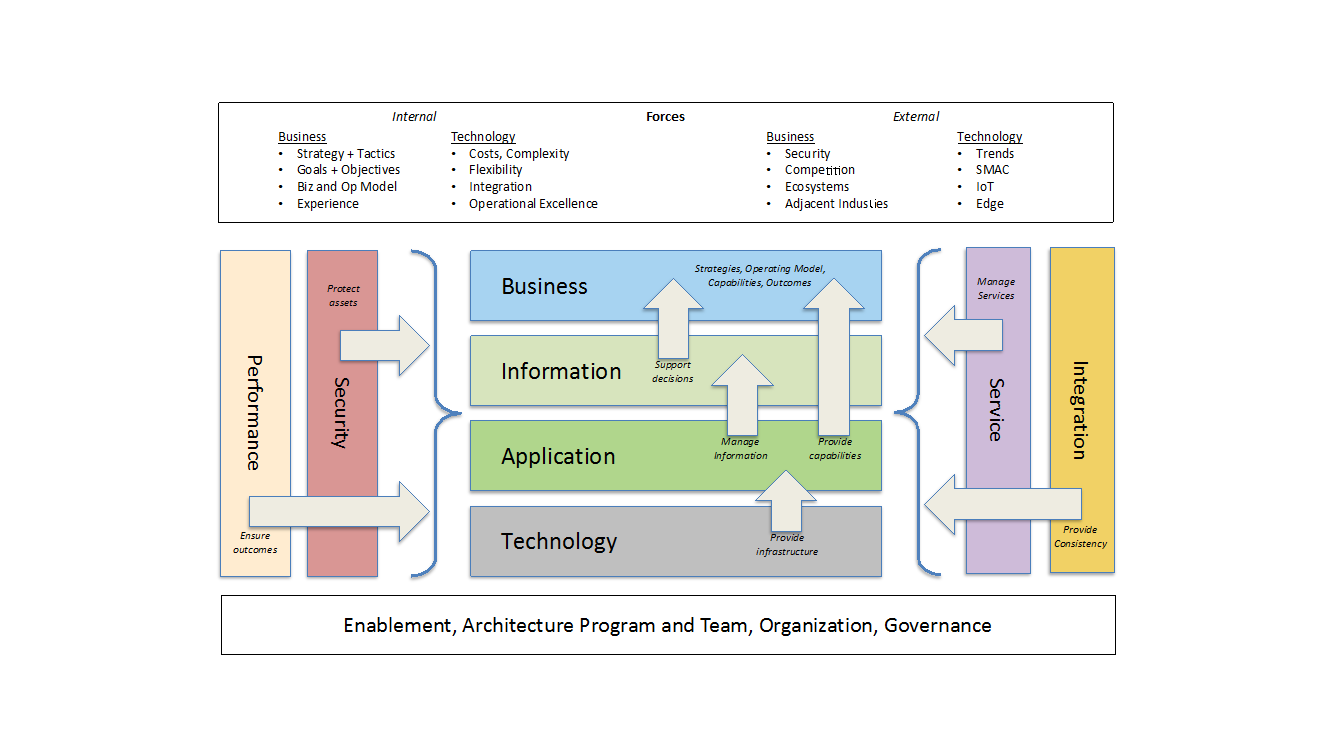Understanding Enterprise Architecture Domains
Multiple forces have combined to create a renewed emphasis in enterprise architecture (EA). First, organizations are more dependent on technology, which continues to expand in importance and complexity. This is compounded by the drive for digital transformation and the need for engaging customer experience and operational efficiency. Finally, COVID-19 has shown that organizations with a good architectural foundation are more successful with the tough decisions and quick changes to business and operating model that the pandemic demands.
The amount and complexity of technology has greatly expanded, and the need for it to work together is critical to digital experience. Enterprise Architecture helps organizations to understand the big picture, what all the pieces are and how they must fit together to achieve transformation, how to integrate them for consistency and interoperability, and how to balance efficiency and effectiveness against agility and flexibility. In an environment where it seems like everything has changed, architecture has also changed to keep pace with the new realities. Architecture gives us a way to understand and manage those new realities and complexity. By decomposing the whole into constituent parts, it allows organizations to address each component in a thoughtful, thorough, and coordinated manner. Then, it allows the ‘big picture context’ to frame information and improve decisions.
For enterprise architecture, the ‘big picture’ includes all aspects of the enterprise in its entire ecosystem. So, in order to manage that scope, architects divide the picture into subject areas (constituent parts), called architectural domains. Figure 1 illustrates the extended domains of enterprise architecture required to fully support digital transformation. The four horizontal domains in the center of the diagram (business, information, application, and technology) represent the traditional view of enterprise architecture. While these are still important, they no longer provide a sufficient model for enterprise IT and its relationship to business and transformation. We extend the model to include four vertical domains (security, performance, integration, and service) whose concerns span across all the traditional domains.
The vertical domains represent a different relationship than the horizontal domains which build on top of each other through a layered structure. Instead, vertical domains must be represented by a holistic architecture that spans all four of the traditional horizontal domains in such a way that the whole is greater than the sum of the parts. In other words, for each vertical domain, specific architectural concerns and implementations at each of the business, information, application, and technology layers must be coordinated and integrated to optimize the enterprise, rather than sub optimizing the particular layer.
The bottom of the figure indicates the organizational aspects of architecture. In other words, architects express the architecture domains in architectural artifacts that are produced by an architecture program as part of some organizational structure. Enablement, helping stakeholders use architecture to influence decisions, is a key focus of architecture teams.

Figure 1 -Enterprise Architecture Context
The domains of enterprise architecture are:
- Business – describes the goals, objectives, strategies, and tactic of the organization. Defines business and operating models and outcomes, business capabilities, information concepts, products and services, value streams, stakeholders, processes, rules. The business domain is critical in helping to prioritize initiatives, transform operating models, and maximize value exchange.
- Information – describes an environment where integrated, consistent, timely information is available as needed, and the cognitive / AI infrastructure for turning that information into knowledge and insight. Identifies old and new sources of data, how they are integrated and aggregated, data transformations, and enterprise wide conceptual and semantic models.
- Application – describes the end-to-end structure of applications, in particular the use of modern architectures such as microservices and data streams, omnichannel access, integration between applications, standard interfaces, etc. Identifies an inventory of applications for portfolio management. The application domain is critical in providing interoperability in support of user experience, in providing flexible services, and in managing cost and complexity.
- Technology – describes the technology infrastructure that supports the enterprise’s digital products, services, applications, and information. Supports the full spectrum of legacy and hybrid multi-cloud platform technologies, communications, integration, IoT, and more. Provides operational excellence and non-functional requirements of availability, reliability, scalability, etc.
- Security – describes the enterprise assets, threats, risks, and vulnerabilities. Defines control objectives and controls, coordinated across all layers of the enterprise, to balance risk, protection, usability, and economics in order to manage threats and responsibilities that make up the “digital trust” of the organization. Security and privacy are critical to the organization and must be a fundamental concern of every architectural domain, initiative, and project, built in from the beginning.
- Performance – describes the desired performance of the enterprise in terms of business outcomes, CSFs, KPIs, and base metrics. Ensures that the necessary information is available to measure outcomes. Provides a framework for instrumenting processes, services, applications, and so on, collecting that information, aggregating, analyzing and displaying information on insights and outcomes.
- Integration – describes how information, applications, processes, and services are integrated to achieve consistent information, function, and user experience. Identifies patterns for end-to-end integration from core and legacy systems through new IT services to end devices. Defines requirements and patterns for integration of cloud service, IoT devices, etc. into the enterprise, including security, accountability, compliance, continuity, semantics, and so on.
- Service – describes the catalog of services provided to support the business needs for information and functions. Supports a hierarchy of services and defines the construction, management and performance of services including metering and pay-per-use options. Services are the new structure of IT delivery and service APIs are key to participating in the digital economy.
There’s more to understanding enterprise architecture, including the disciplines and practices, principles, frameworks, tools, deliverables, programs, teams, governance and so on, but hopefully this introduction of the architectural concepts will help in your understanding of the why and what of architecture.
